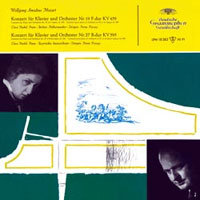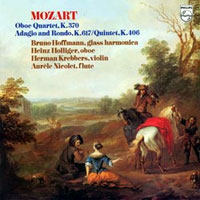Mozart • Concertos for Piano and Orchestra Nos. 19 and 27
Mozart • Oboe Quartet, Adagio and Rondo, String Quintet
ere are mono and stereo LPs of Mozart compositions from two different labels and with two different repertoires. The Deutsche Grammophon recording collects a pair of Mozart’s finer piano concertos. While Mozart didn’t invent the piano concerto, he was the first to give it serious attention, and he certainly defined the standard for all composers who followed him. Clara Haskil and the Berliner Philharmoniker give a mostly jaunty, upbeat performance of Concerto No. 19, though it's a tad plodding in places. Her performance of No. 27, the last piano concerto Mozart wrote, is somber, but it manages to find the essence of the composer's intent. My favorite No. 27 is Clifford Curzon's on Decca (I have a London reissue LP and an Esoteric SACD of the original Decca recording). Haskil is as involving as Curzon, but where Haskil is reserved, Curzon is analytical. I’d hate to be without either performance. This reissue gives us a glimpse of the purity of tone and the precise phrasing that were hallmarks of Clara Haskil’s playing, a style lost too soon in 1965, when Haskil sustained critical injuries in a fall from a train. Her friend Charlie Chaplin considered her genius on par with Albert Einstein's and Winston Churchill's. The sound of the piano on this mono LP is lifelike, and the orchestra is clearly set slightly behind. The balance is such that neither overpowers the other. The quiet surfaces go a long way toward intensifying the recording's inherent clarity. The chamber works on the Philips LP are a completely different kettle of fish. Here Mozart was writing for a specific talented friend -- something he did both to honor and challenge his musical acquaintances. These works were meant to be played in more intimate settings, and the performances here convey a feeling of you-are-thereness. I was especially taken with the Adagio and Rondo for glass harp. The delicate sound of the instrument is easily overwhelmed, yet the performance allows all of the instruments to shine forth. Bruno Hoffmann demonstrates a mastery of the instrument that would have made Mozart smile. Just as rewarding is the longer Quintet in C minor. It’s clear that these musicians have played together for many years, as they work with and off each other, communicating in a way that is complimentary to the music and the composer's intent. The stereo Philips LP offers a slightly cleaner, clearer view than the Deutsche Grammophon mono recording, again with quiet surfaces that allow the full tone and timbre of each instrument to blossom. I’ve noted the realistic sound of the glass harp, but the viola is even more vivid. While many good recordings of Mozart’s chamber music
exist, I understand why Speakers Corner chose to reissue this one: Superb performances, a
unique repertoire and sterling sonics make for a thoroughly enjoyable LP. |


